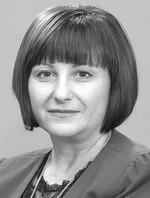Effects of sporting activities on age-specific morphological maturity of 7-16 year-old schoolchildren
Фотографии:
ˑ:
Fizicheskaya kultura: vospitanie, obrazovanie, trenirovka №3-2017, pp.5-8
Dr.Hab., Professor N.I. Dvorkina1
Dr.Hab., PhD, Professor L.S. Dvorkin2
A.I. Popov1
1Kuban State University of Physical Culture, Sport and Tourism, Krasnodar
2Children's and Youth Sports School named after V.N. Machuga of Pereyaslovskaya village, Bryukhovetsky district, Krasnodar region
The study was designed to rate effects of sporting activities (athletic gymnastics and running) on age-specific morphological maturity of 7-16 year-old schoolchildren. The morphological maturity of the subjects was rated by the following criteria: body length, body weight, hand strength, back strength and Quetelet index. The subjects were split up into two sport groups (all boys), one group (n=20) trained in athletic gymnastics and the other group (n=21) in sprint and middle-distance running. The subjects morphological maturity was rated by the morphological maturity index (MMI, in standard units) calculated using the proposed formula. The study data and analyses showed that the effects of physical activity versus the MMI are insignificant for the 7-10 year-olds. The MMI of the 11-16 year-olds were found more sensitive to the strength-building athletic gymnastics in the boys’ sexual maturation (pubescence) period when the muscular mass grows. The group progress as verified by the MMI in this age period was found higher versus that of the sprinters and middle-distance runners’ group.
Keywords: morphological maturity, age specifics, index, schoolchildren, educational process rates, athletic gymnastics, track sports.Keywords: physical load, academic sports, students, mental and physiological conditions.
References
- Dvorkin L.S., Chernyshenko Y.K. Nauchno-pedagogicheskie osnovy mnogoletney podgotovki molodykh atletov. T. 3 [Scientific and pedagogical basics of long-term training of junior athletes. V. 3]. Bazovaya fizicheskaya podgotovka vysokokvalifitsirovannykh sportsmenov v razlichnykh vidakh edinoborstv [Basic physical training of highly skilled athletes in various martial arts disciplines]. Krasnodar: Neoglori publ., 2011, pp. 5-112.
- Dvorkin L.S., Akhmetov S.M. Atletizm v sisteme fizicheskogo vospitaniya i sporta (istoriya, teoriya, metodika i tehnologiya) [Body building in physical education and sport system (history, theory, methodology and technology)]. Krasnodar, 2012, 688 p.
- Zatsiorskiy V.M. Fizicheskie kachestva sportsmena: osnovy teorii i metodiki vospitaniya [Athlete's physical qualities: fundamentals of theory and methods of development]. Sovetskiy sport publ., 2009, 200 p.
- Yeger Y.M., Kryuger K. Myshtsy v sporte. Anatomiya. Fiziologiya. Trenirovka. Reabilitatsiya [Muscles in sport. Anatomy. Physiology. Training. Rehabilitation]. Transl. from German, gen. ed. D.G. Kalashnikov. Moscow: Prakticheskaya meditsina publ., 2016, 408 p.
- Rozhkovets V.V., Menshikov A.I. Nauchno-pedagogicheskie osnovaniya primeneniya dozirovannykh otyagoshcheniy dlya razvitiya vzryvnoy sily u podrostkov (na primere begunov na korotkie distantsii i bortsov greko-rimskogo stilya). T. 3 [Scientific and pedagogical grounds for using graded loads to develop explosive strength in adolescents (case study of sprinters and Greco-Roman wrestlers). V. 3]. Bazovaya fizicheskaya podgotovka vysokokvalifitsirovannykh sportsmenov v razlichnykh vidakh edinoborstv [Basic physical training of highly skilled athletes in various martial arts disciplines]. Krasnodar: Neoglori publ., 2011, pp. 113-183.
- Tegako L., Klementinskiy E. Antropologiya. Ucheb. posobie [Anthropology. Study guide]. Moscow: Novoe znanie publ., 2004, 400 p.


